Page 463 of 615
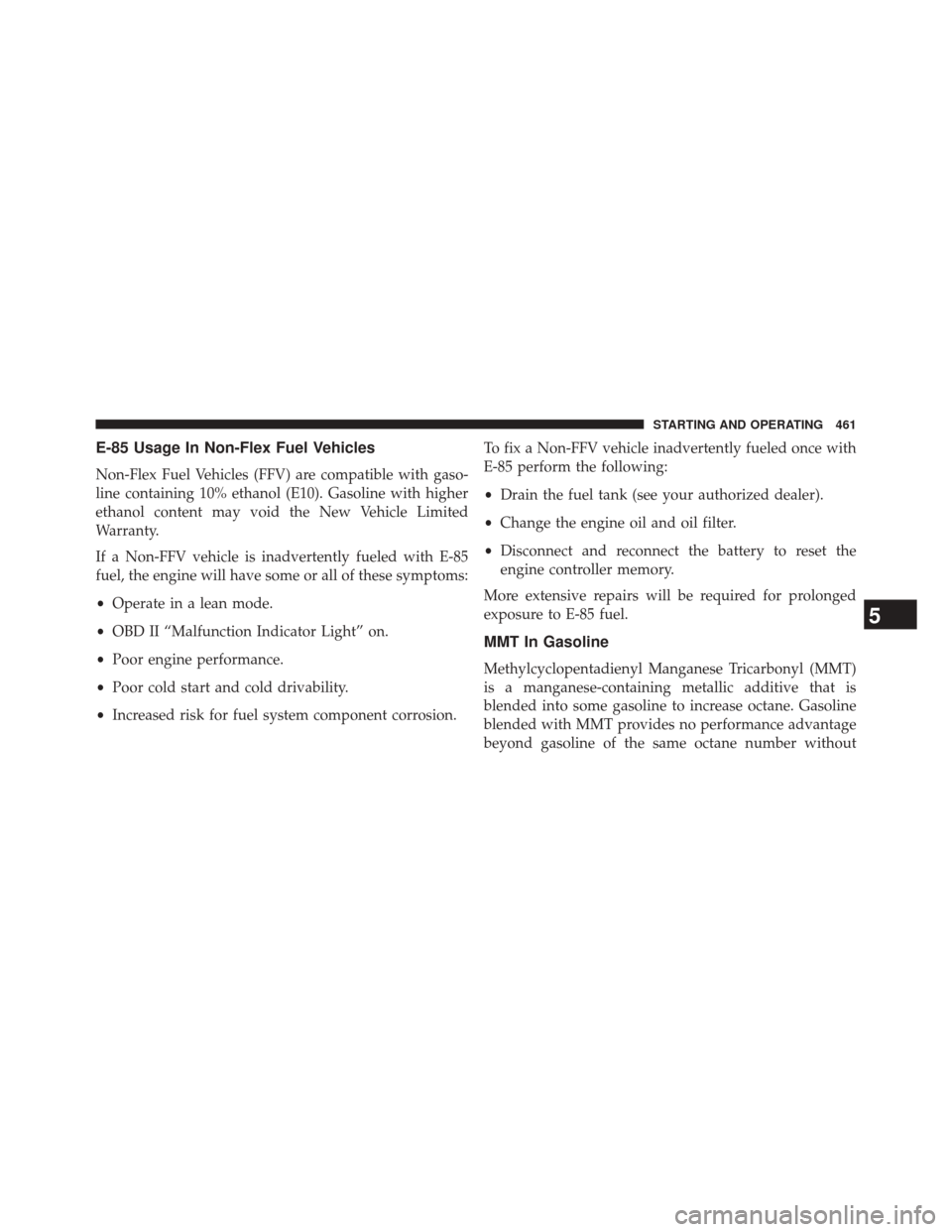
E-85 Usage In Non-Flex Fuel Vehicles
Non-Flex Fuel Vehicles (FFV) are compatible with gaso-
line containing 10% ethanol (E10). Gasoline with higher
ethanol content may void the New Vehicle Limited
Warranty.
If a Non-FFV vehicle is inadvertently fueled with E-85
fuel, the engine will have some or all of these symptoms:
•Operate in a lean mode.
• OBD II “Malfunction Indicator Light” on.
• Poor engine performance.
• Poor cold start and cold drivability.
• Increased risk for fuel system component corrosion. To fix a Non-FFV vehicle inadvertently fueled once with
E-85 perform the following:
•
Drain the fuel tank (see your authorized dealer).
• Change the engine oil and oil filter.
• Disconnect and reconnect the battery to reset the
engine controller memory.
More extensive repairs will be required for prolonged
exposure to E-85 fuel.
MMT In Gasoline
Methylcyclopentadienyl Manganese Tricarbonyl (MMT)
is a manganese-containing metallic additive that is
blended into some gasoline to increase octane. Gasoline
blended with MMT provides no performance advantage
beyond gasoline of the same octane number without
5
STARTING AND OPERATING 461
Page 486 of 615
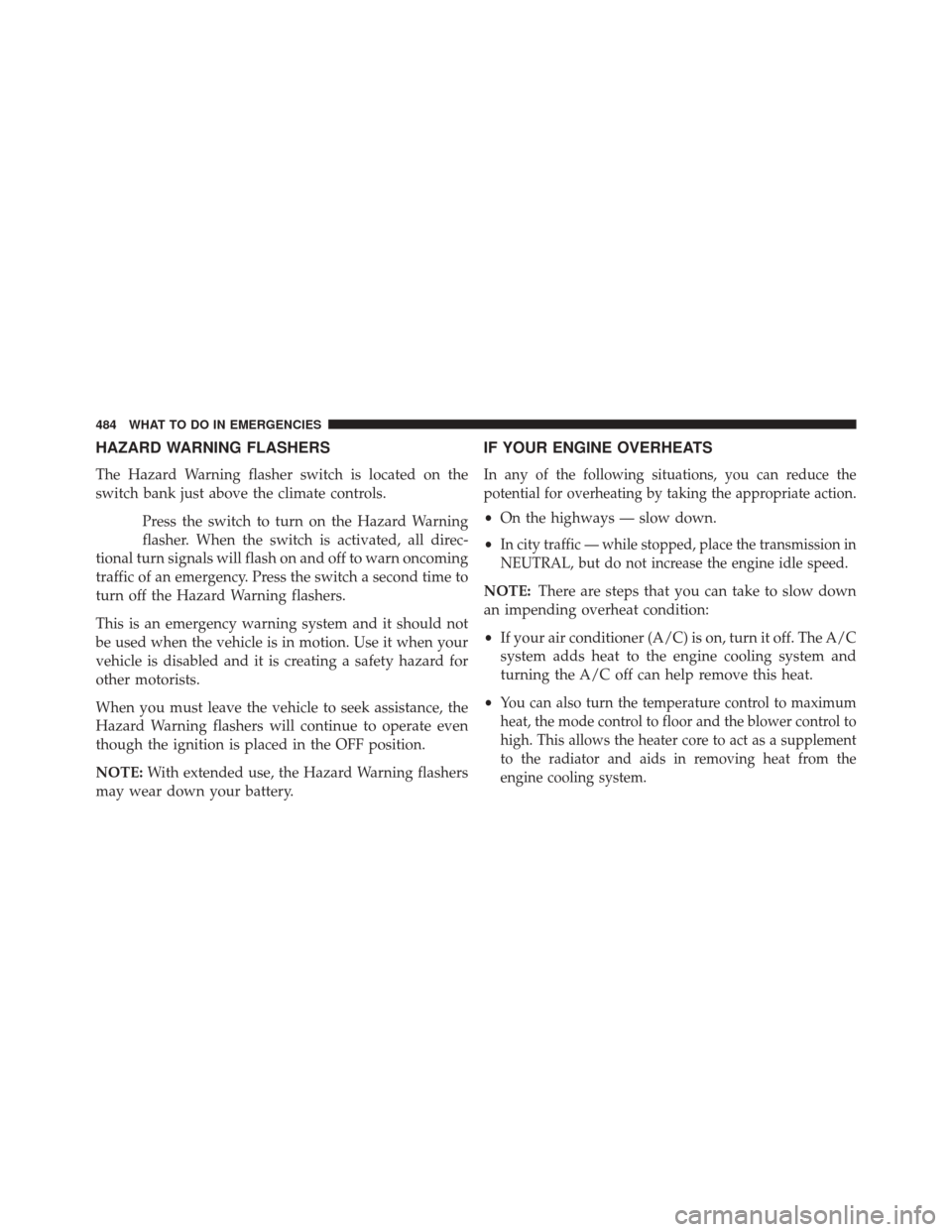
HAZARD WARNING FLASHERS
The Hazard Warning flasher switch is located on the
switch bank just above the climate controls.Press the switch to turn on the Hazard Warning
flasher. When the switch is activated, all direc-
tional turn signals will flash on and off to warn oncoming
traffic of an emergency. Press the switch a second time to
turn off the Hazard Warning flashers.
This is an emergency warning system and it should not
be used when the vehicle is in motion. Use it when your
vehicle is disabled and it is creating a safety hazard for
other motorists.
When you must leave the vehicle to seek assistance, the
Hazard Warning flashers will continue to operate even
though the ignition is placed in the OFF position.
NOTE: With extended use, the Hazard Warning flashers
may wear down your battery.
IF YOUR ENGINE OVERHEATS
In any of the following situations, you can reduce the
potential for overheating by taking the appropriate action.
• On the highways — slow down.
•
In city traffic — while stopped, place the transmission in
NEUTRAL, but do not increase the engine idle speed.
NOTE: There are steps that you can take to slow down
an impending overheat condition:
• If your air conditioner (A/C) is on, turn it off. The A/C
system adds heat to the engine cooling system and
turning the A/C off can help remove this heat.
•
You can also turn the temperature control to maximum
heat, the mode control to floor and the blower control to
high. This allows the heater core to act as a supplement
to the radiator and aids in removing heat from the
engine cooling system.
484 WHAT TO DO IN EMERGENCIES
Page 505 of 615
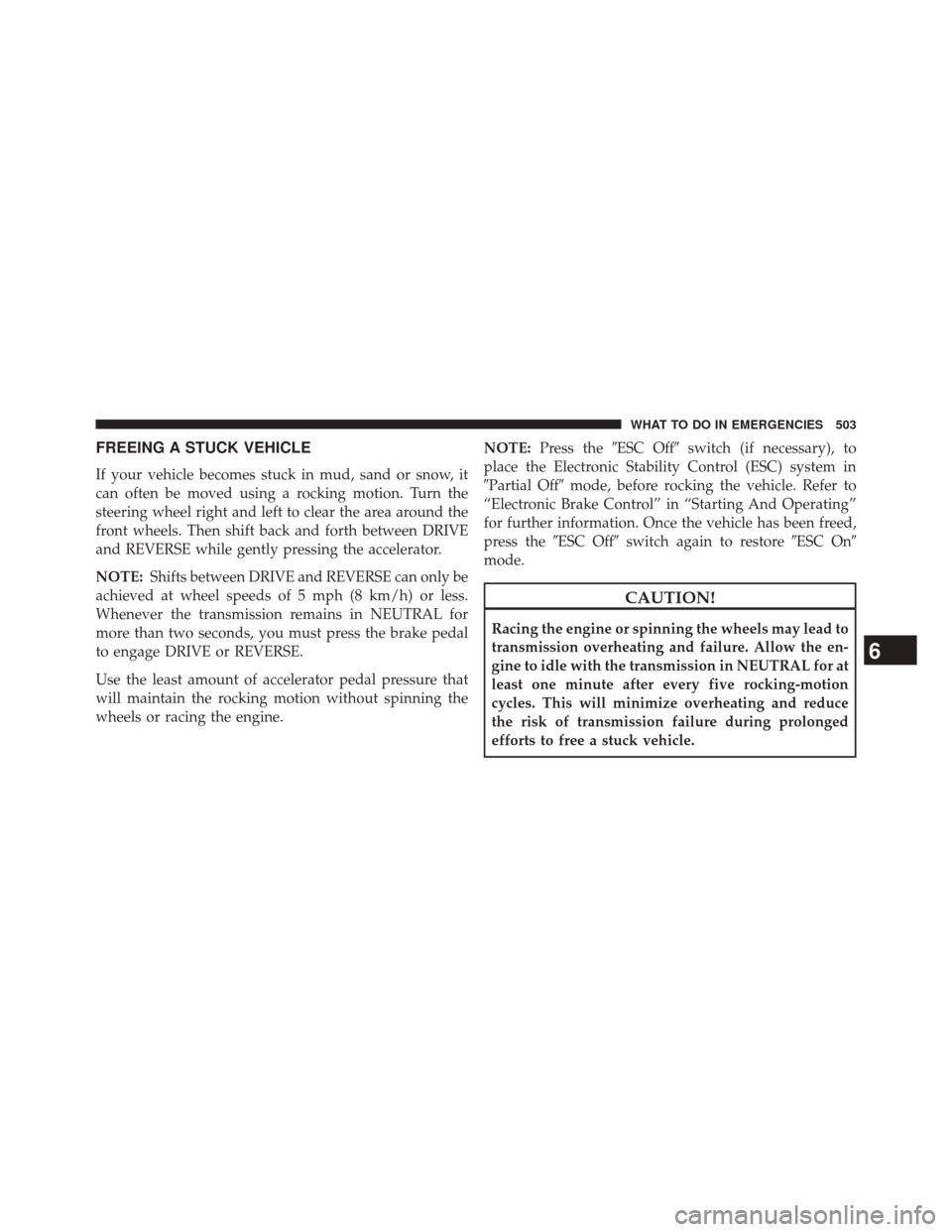
FREEING A STUCK VEHICLE
If your vehicle becomes stuck in mud, sand or snow, it
can often be moved using a rocking motion. Turn the
steering wheel right and left to clear the area around the
front wheels. Then shift back and forth between DRIVE
and REVERSE while gently pressing the accelerator.
NOTE:Shifts between DRIVE and REVERSE can only be
achieved at wheel speeds of 5 mph (8 km/h) or less.
Whenever the transmission remains in NEUTRAL for
more than two seconds, you must press the brake pedal
to engage DRIVE or REVERSE.
Use the least amount of accelerator pedal pressure that
will maintain the rocking motion without spinning the
wheels or racing the engine. NOTE:
Press the �ESC Off� switch (if necessary), to
place the Electronic Stability Control (ESC) system in
�Partial Off� mode, before rocking the vehicle. Refer to
“Electronic Brake Control” in “Starting And Operating”
for further information. Once the vehicle has been freed,
press the �ESC Off� switch again to restore �ESC On�
mode.
CAUTION!
Racing the engine or spinning the wheels may lead to
transmission overheating and failure. Allow the en-
gine to idle with the transmission in NEUTRAL for at
least one minute after every five rocking-motion
cycles. This will minimize overheating and reduce
the risk of transmission failure during prolonged
efforts to free a stuck vehicle.
6
WHAT TO DO IN EMERGENCIES 503
Page 601 of 615
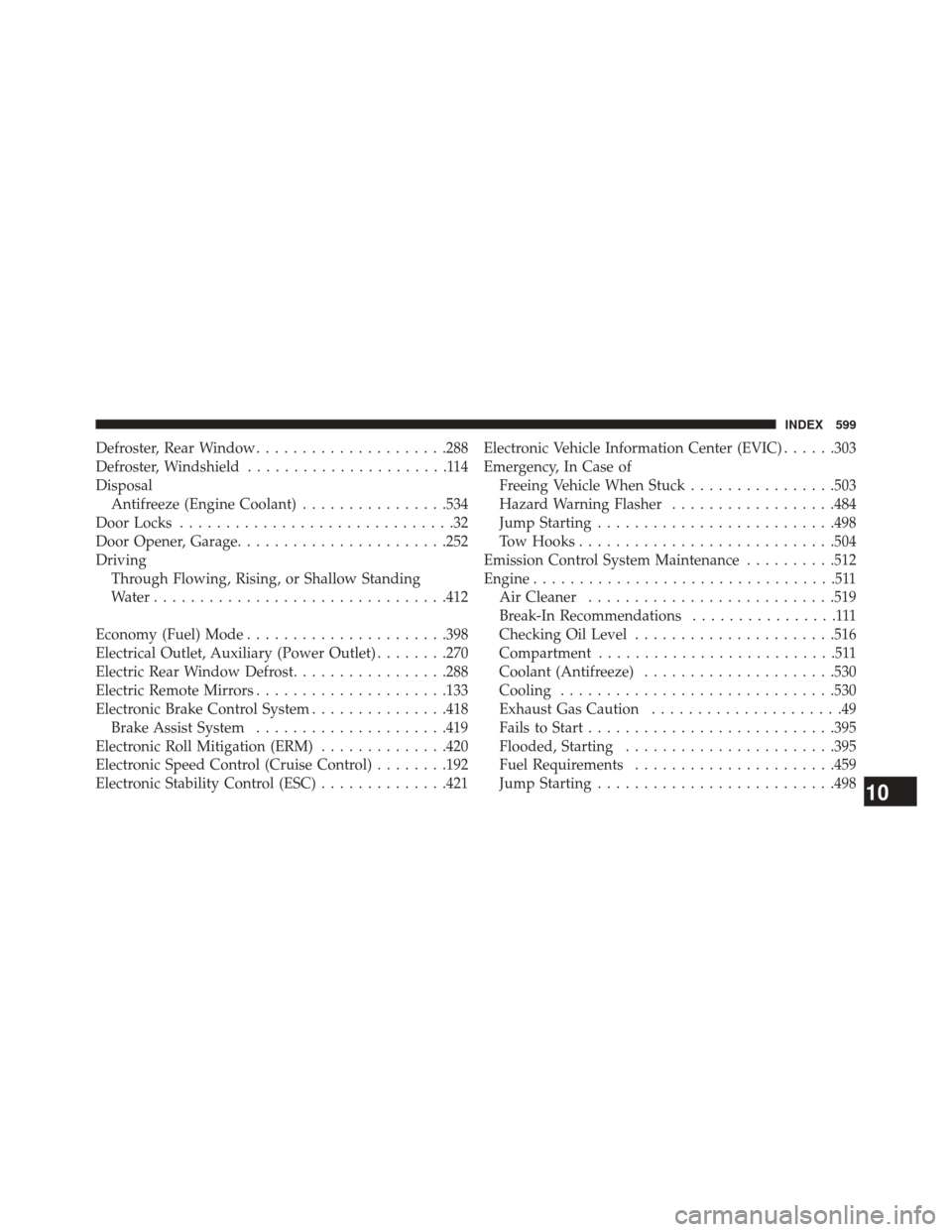
Defroster, Rear Window.....................288
Defroster, Windshield ......................114
Disposal Antifreeze (Engine Coolant) ................534
Door Locks ..............................32
Door Opener, Garage ...................... .252
Driving Through Flowing, Rising, or Shallow Standing
Water ............................... .412
Economy (Fuel) Mode ..................... .398
Electrical Outlet, Auxiliary (Power Outlet) ........270
Electric Rear Window Defrost .................288
Electric Remote Mirrors .....................133
Electronic Brake Control System ...............418
Brake Assist System .....................419
Electronic Roll Mitigation (ERM) ..............420
Electronic Speed Control (Cruise Control) ........192
Electronic Stability Control (ESC) ..............421Electronic Vehicle Information Center (EVIC)
......303
Emergency, In Case of Freeing Vehicle When Stuck ................503
Hazard Warning Flasher ..................484
Jump Starting ......................... .498
Tow Hooks ........................... .504
Emission Control System Maintenance ..........512
Engine .................................511
Air Cleaner .......................... .519
Break-In Recommendations ................111
Checking Oil Level ..................... .516
Compartment ..........................511
Coolant (Antifreeze) .....................530
Cooling ............................. .530
Exhaust Gas Caution .....................49
Fails to Start .......................... .395
Flooded, Starting ...................... .395
Fuel Requirements ..................... .459
Jump Starting ......................... .498
10
INDEX 599
Page 603 of 615
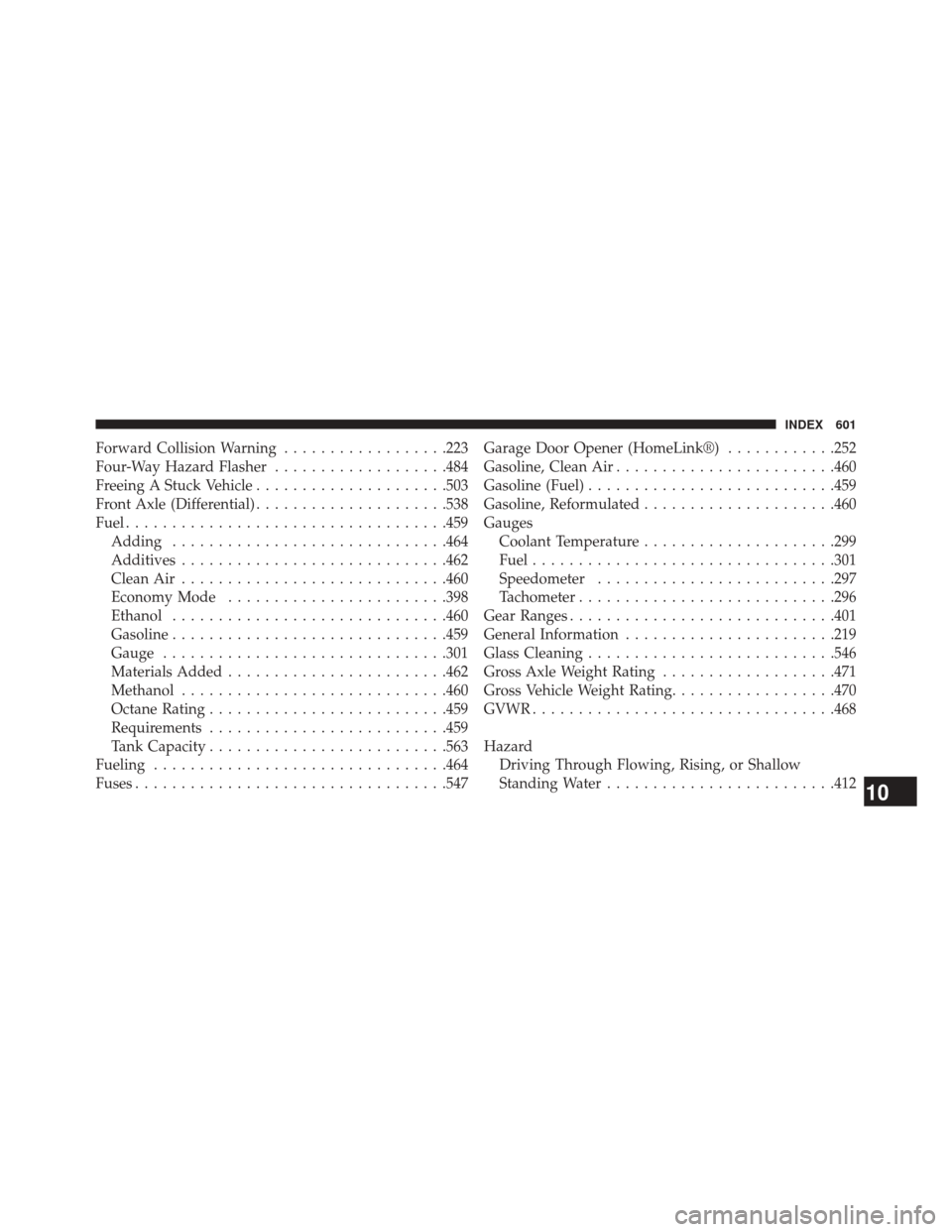
Forward Collision Warning..................223
Four-Way Hazard Flasher ...................484
Freeing A Stuck Vehicle .....................503
Front Axle (Differential) .....................538
Fuel .................................. .459
Adding ............................. .464
Additives ............................ .462
Clean Air ............................ .460
Economy Mode ....................... .398
Ethanol ............................. .460
Gasoline ............................. .459
Gauge .............................. .301
Materials Added ....................... .462
Methanol ............................ .460
Octane Rating ......................... .459
Requirements ......................... .459
Tank Capacity ......................... .563
Fueling ............................... .464
Fuses ................................. .547Garage Door Opener (HomeLink®)
............252
Gasoline, Clean Air ....................... .460
Gasoline (Fuel) .......................... .459
Gasoline, Reformulated .....................460
Gauges Coolant Temperature .....................299
Fuel ................................ .301
Speedometer ......................... .297
Tachometer ........................... .296
Gear Ranges ............................ .401
General Information ...................... .219
Glass Cleaning .......................... .546
Gross Axle Weight Rating ...................471
Gross Vehicle Weight Rating ..................470
GVWR ................................ .468
Hazard Driving Through Flowing, Rising, or Shallow
Standing
Water........................ .412
10
INDEX 601